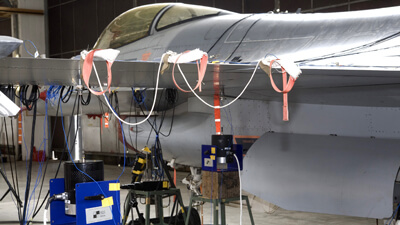Ground Vibration Testing and Flutter Analysis
Ground Vibration Testing (GVT) is a procedure used to assess the structural response and dynamic characteristics of an aircraft, spacecraft, or other mechanical systems when subjected to vibration and ground-induced loads. It involves subjecting the structure to controlled vibrations while measuring its response using sensors and instruments.
The primary objectives of Ground Vibration Testing are to:
Validate structural integrity: GVT helps verify the structural integrity of an aircraft by assessing its ability to withstand the vibration loads it may encounter during operation. By subjecting the structure to representative vibration inputs, BHSPL generates reports to identify potential structural weaknesses or resonance issues that could affect its performance and safety.
Identify natural frequencies and mode shapes: GVT helps determine the natural frequencies and mode shapes of the structure. Natural frequencies are the frequencies at which the structure tends to vibrate with the least amount of external excitation. Mode shapes describe the patterns of vibration exhibited by the structure at different frequencies. Understanding these characteristics is crucial when integrating a store or external component to an aircraft.
Correlate with analytical models: GVT data is used to validate and refine computer-based analytical models, such as finite element models. By comparing the predicted responses from these models with the measured responses during GVT, BHSPL assesses the accuracy of their simulations and make necessary adjustments to improve the models’ predictive capabilities.
During GVT, the aircraft is mounted with shakers which generates controlled vibrations. In addition, aircraft tyres are deflated to 50% air pressure to mimic aircraft being in air. Sensors such as accelerometers, strain gauges, and displacement transducers are attached to different points on the structure to measure its response. The vibrations are applied at various frequencies and amplitudes to stimulate different modes of vibration. Upon excitation, all the data is recorded and subsequently analyzed to determine the modal frequencies, oscillations and damping behaviours which is finally compiled as a report for clearance from regulatory authority such as RCMA / CEMILAC.
Overall, Ground Vibration Testing is a crucial step in the development, certification, and performance evaluation of aerospace and mechanical systems, ensuring their structural integrity, reliability, and compliance with safety standards.
BHSPL offers GVT services for integration of airborne mechanical structures to be integrated on existing platforms and it is a key and crucial element towards certification program.

Ground Vibration Testing plays a crucial role in flutter analysis by providing valuable data and insights into the dynamic characteristics of an aircraft or structure. Flutter is an aerodynamic instability phenomenon that can occur when certain speeds or conditions are met, resulting in potentially catastrophic vibrations.
Flutter is a dynamic instability of an elastic structure in a fluid flow, caused by positive feedback between the body’s deflection and the force exerted by the fluid flow.
Flutter needs to be avoided since this can be a catastrophic event, and total loss of the airframe is possible. Model predictions need to be supplemented with ground testing to build up absolute confidence in the predictions.
For every integration program required for any platform, BHSPL undertakes the two closely related dynamic tests to be performed on aircraft which are are Ground Vibration Tests (GVT) and Flutter Tests. These tests are considered essential to define the safe flight “envelope” for a given aircraft configuration:
While GVT is a modal test of the entire airframe, which determines the resonant frequencies, modeshapes, and damping. This is normally performed on the aircraft before first flight while it is still on the “ground”. GVT modal results are compared with the structural Finite Element Model used for flutter predictions. If the models and test results agree, the aircraft is cleared for the next round of tests, which usually includes ground runs and a flight flutter investigation.
Flutter is an in-flight phenomenon which causes the wings and other key components to vibrate uncontrollably, due to the convergence of multiple modes as the resonance and damping shift due to aero-elastic loading, making flight impossible. Before flying an actual aircraft, flutter performance is predicted, so the flight envelope (altitude and speed) of the aircraft is safely bounded. This is later verified by performing a flutter test with the actual aircraft.
The analytical flutter predictions bring together a structural model and an aerodynamic model. The aerodynamic model is verified by scale model testing in a wind tunnel, while the structural model is verified by GVT testing.
The duration of the GVT campaign typically requires from a few days to a couple of weeks, depending on the size of the airframe, the number of channels, the number of different payload or mission configurations, etc. apart from support from the airframe owner such as IAF or Indian Navy to allow the aircraft to be grounded during the testing period.
